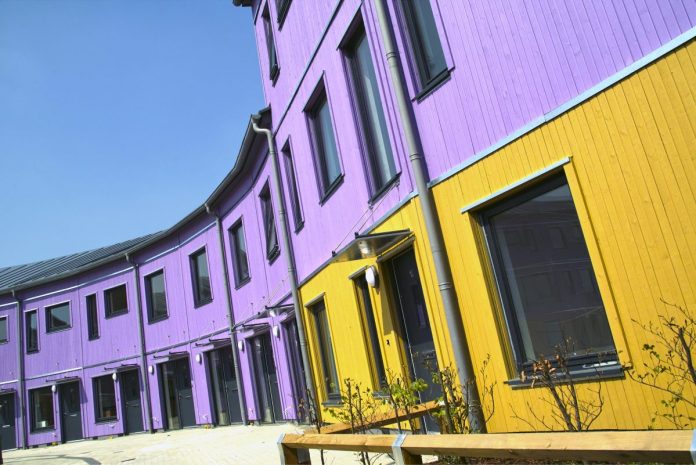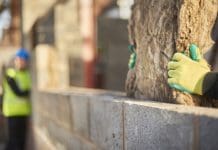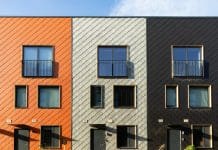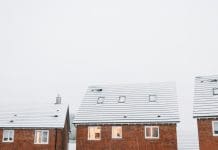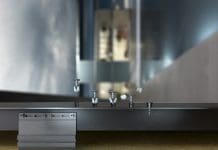Offsite timber construction could meet much of the government’s target for new housing, says Alex Goodfellow, Chairman of the Structural Timber Association. Here, he takes an in-depth look at the benefits of structural timber solutions
The acute demand for quick, sustainable and high quality solutions to the current shortfall in housing stock has resulted in offsite timber construction becoming a key building method to meet the demand for affordable housing. This readily available modern method of construction (MMC) has been adopted by many social housing providers to deliver quick, sustainable and energy efficient homes.
As well as being widely available in the UK and with the initial benefits of speed of build, the low carbon offsite timber construction method reduces ongoing energy costs for tenants. It also keeps maintenance and whole-life costs to a minimum, which is crucial for social housing providers.
Developers, architects and engineers now recognise the positive impact of material selection, building details and specification on energy performance and build quality, and are keen to promote best practice.
The construction of a house maximising offsite timber construction technology typically takes around six weeks to build, which is nearly a quarter of the time taken by traditional methods, with an average timescale of over 20 weeks. This speed benefit reduces overall build costs, enables more homes to be completed each year and helps ensure a project comes in on time and on budget.
There are a broad range of structural timber solutions that have a secure, sustainable source of materials and resources, and can deliver the volume the country needs to tackle the current housing crisis. The timber design and manufacturing sector is already well established and can add further capacity at a relatively rapid rate to meet increasing housing demand.
Continual technical development in the sector has resulted in many new and innovative structural timber products coming to market and now offers residential housing providers and developers a strong support network and a wealth of choice to meet the specific needs of various building forms, architectural styles and planning requirements.
It is important to specify the right structural timber solution for the job – a system that can not only meet the budget but also the energy, acoustic and structural performance requirements of any building design. There is a vast array of options within the timber technology portfolio that can deliver high performance commercial buildings and new homes including:
 Timber Frame
Timber Frame
Modern timber frame structures are precision-engineered, strong and durable. The build method relies on a factory manufactured timber frame as a means of structural support – carrying the loads imposed by the floors and roofs, before transmitting them to the foundations – which can be built at a lower cost due to the buildings being lightweight.
The construction of timber frame-based structures utilises factory manufactured wall panels, floor and roof panels. The systems used are classified as either open panel, insulated or closed panel. These panels can include the wall insulation pre-fitted and can include the pre-fitting of doors, windows and service zones for on-site installation of M&E works.
Timber frame currently accounts for around a quarter of all new homes being built in the UK. This build method is used by every sector of the construction industry, including social housing providers, due to timber frame’s superb environment credentials, as well as being quick and easy to construct.
Open panel
Timber frame open panel systems are structurally engineered panels that form the inside load-bearing leaf of the external wall, comprising studs, rails, sheathing on one face and a breather membrane.
The open panel system is made from treated softwood timber framing, over which a structural sheet material of either ply or OSB board is fixed. Depending on the system, U-values ranging from 0.26 down to 0.15 W/m²K, can be achieved.
Closed panel
Made from studs, rails and insulation, with sheathings and/or linings on the faces of the panel. A vapour barrier is also provided on the warm side of the insulation and a breather membrane on the outer face of the panel. If desired, closed panels may also include fitted windows and internal service zone battens for ease of installation and construction. U-values from 0.25 right down to 0.10 W/m²K can be achieved. These solutions have been designed to deliver excellent thermal and airtightness properties and are ideal as the basis of a modern energy efficient home.
Structural Insulated Panel Systems (SIPS)
Structural Insulated Panels are an advanced method of construction, exploiting composite panel techniques – delivering excellent structural and thermal characteristics in one system. SIPS have two parallel faces – usually Oriented Strand Board (OSB) – sandwiching a rigid core of Polyurethane (PUR) foam.
The result is a lightweight system that is quick to erect and free from the complications surrounding compression shrinkage and thermal bridging often associated with other forms of construction.
Delivering rapid and robust energy efficient buildings, with superior insulation, structural strength and airtightness – SIP systems are used for walls, roofs and floors. Structural Insulated Panels offer extremely high thermal performance throughout the lifecycle of the building, while minimising wall thickness. The PUR core of rigid insulation and OSB3 facing panels achieve U-values as low as 0.10 W/m²K, making significant savings on operating costs.
Using SIPS technology for residential applications will reduce build programmes, enabling houses to be completed much faster than conventional building methods. If the house design facilitates habitable living space in the roof zone then SIPS are a fantastic solution, as they do not require roof trusses, ensuring maximum space availability, while providing superb thermal performance and limited air leakage.
Infill walling
SIPS are often specified as infill to steel, concrete or engineered timber structural frames and can sit inside or outside the frame itself. Infill walling is incredibly quick to install, making it an innovative solution for high-rise residential applications to deliver a rapid dry building envelope.
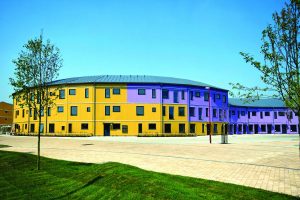 Full structural wrap
Full structural wrap
Structural Insulated Panels Systems can be used to form a load-bearing full structural wrap. Currently five storeys are the maximum practical height for loadbearing SIP buildings. Above this, an additional structure needs to be incorporated into the building to carry the imposed load.
Cross-laminated timber
Cross-laminated timber (CLT) is a structural two-way spanning timber panel that can be used to form walls, roof and floor panels, as well as shear walls. It is produced by stacking a number of layers of timber, known as lamellas, at 90º to the layer below and subsequently glued to create panels of up to 24m in length and 2,950mm in width, which can encompass between three and seven layers.
Cross-laminated timber is now extensively used across the commercial, leisure and education construction sectors, and the benefits have been widely acknowledged, but the technology has not been prolifically used in residential developments in the UK – until now. It is in medium-rise residential developments where the advantages of CLT as a core structural solution truly come into play. The key is in the strength-to-weight ratio of the engineered timber.
It has proven multi-storey capability, with residential buildings up to 10 storeys already constructed in the UK and a structural capacity beyond this.
The benefits during construction are numerous, from reduced loading on foundations and infrastructure services to impressive thermal, acoustic and airtightness performance over more traditional materials. Most importantly, a CLT construction solution provides cost and programme certainty.
As structural timber systems have gained traction across the industry, the STA’s mission is to enhance quality and drive product innovation through technical guidance and research, underpinned by a members’ quality standard assessment – STA Assure.
This scheme offers reassurances to the construction community that STA members meet or even exceed current legislation and regulatory requirements.
This is underpinned by a strong and well established industry within structural timber that has a fully integrated supply chain and a diverse range of businesses readily available to provide UK-wide coverage.
There is a wealth of information available to construction professionals on the Structural Timber Association website, from advice on structural timber systems to market reports and an online member’s enquiry system. For more information visit: www.structuraltimber.co.uk.
Alex Goodfellow
Chairman
Structural Timber Association
Tel: +44 (0)1259 272140
Twitter: @STAtimber


